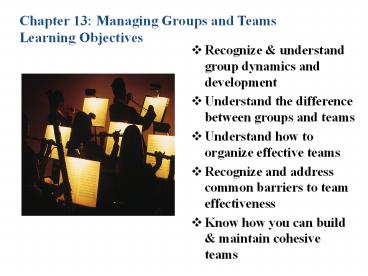Chapter 13: Managing Groups and Teams Learning Objectives - PowerPoint PPT Presentation
1 / 25
Title:
Chapter 13: Managing Groups and Teams Learning Objectives
Description:
Chapter 13: Managing Groups and Teams Learning Objectives Recognize & understand group dynamics and development Understand the difference between groups and teams – PowerPoint PPT presentation
Number of Views:299
Avg rating:3.0/5.0
Title: Chapter 13: Managing Groups and Teams Learning Objectives
1
Chapter 13 Managing Groups and Teams Learning
Objectives
- Recognize understand group dynamics and
development - Understand the difference between groups and
teams - Understand how to organize effective teams
- Recognize and address common barriers to team
effectiveness - Know how you can build maintain cohesive teams
2
Group and Team Management in the P-O-L-C
Framework
3
(No Transcript)
4
Types of Groups Formal and Informal
5
(No Transcript)
6
(No Transcript)
7
(No Transcript)
8
(No Transcript)
9
Social Loafing and Collective Efficacy
10
(No Transcript)
11
(No Transcript)
12
(No Transcript)
13
Three Major Classes of Team Tasks
14
(No Transcript)
15
Team Role Typology
- These 10 roles include task roles (light yellow),
social roles (medium orange), and boundary
spanning roles (dark orange)
16
- A task force is a temporary team which is asked
to address a specific issue or problem until it
is resolved - A product development team can be temporary or
ongoing - A cross-functional team appears in matrix
organizations where individuals from different
parts of the organization staff the team which
may be temporary or long standing in nature
17
- Upwards of 8.4 million individuals worldwide work
virtually in at least one team - virtual teams are formed to take advantage of
distributed expertise or time - Challenges of Virtual Teams
- Building trust is difficult
- If individuals in a virtual team are not fully
- engaged and tend to avoid conflict,
- team performance can suffer
18
Team leadership is a major determinant of how
autonomous a team can be
19
Designing Effective Teams
20
(No Transcript)
21
(No Transcript)
22
(No Transcript)
23
(No Transcript)
24
(No Transcript)
25
Building Your Cohesive Team

